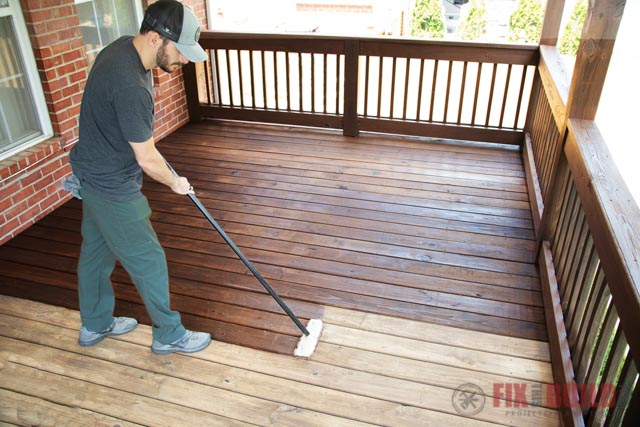Water-Based Stains for a Beautiful Deck: Eco-Friendly and Effective
Water-Based Stains for a Beautiful Deck: Eco-Friendly and Effective
Blog Article
A Comprehensive Guide to Various Sorts Of Deck Staining Techniques for Ultimate Security and Appearances
In the world of deck upkeep, the art of discoloring stands as a critical step in the direction of both maintaining the stability of your outdoor room and boosting its aesthetic appeal. As we navigate via the complex globe of deck discoloration methods, one starts to appreciate the nuanced methods that can make all the distinction between an average surface and a remarkable one.
Recognizing Different Sorts Of Spots
Numerous types of discolorations are typically used in the procedure of deck staining to accomplish various aesthetic and protective results. On the other hand, semi-transparent stains offer an equilibrium between color enhancement and security, permitting some timber grain to reveal via.
Toners add a tip of color to the wood while providing very little security, making them appropriate for more recent decks with less wear. Comprehending the features and advantages of each kind of discolor is critical for attaining the preferred appearance and longevity for your deck.
Selecting the Right Spot Shade
When thinking about the visual appeals of your deck discoloration job, the option of stain color plays a critical role in enhancing the protective qualities of the picked tarnish kind (Right Deck Stain). The color you select can substantially affect the overall look of your deck, as well as its capability to withstand the components over time
When picking a stain color, it's necessary to take into consideration the existing color design of your home's exterior. Integrating the deck discolor with the overall visual of your building can produce a cohesive and aesthetically appealing outside area. In addition, the color of your deck tarnish can affect the temperature level of the deck surface area; darker shades often tend to take in even more warmth, while lighter shades mirror sunshine and stay cooler.
In addition, the sort of wood you are staining will also impact how the tarnish shade shows up. Different timber species can communicate with the discolor in numerous means, potentially modifying the final shade. It's a good idea to test the tarnish on a small, unnoticeable area of the deck to ensure the color ends up as wanted before waging the whole job.
Preparing Your Deck for Staining
To guarantee a effective and resilient deck staining project, detailed preparation of the deck surface area is important. Begin by cleaning up the deck extensively to remove dust, grime, mildew, and any type of old tarnish or end up. Utilize a deck cleaner or a blend of water and cleaning agent in addition to a tight brush or stress washing machine to scrub the surface area clean. After cleaning, enable the deck to completely dry entirely prior to relocating wikipedia reference on to the following action.
Evaluate the deck for any type of damaged or rotten boards that need to be changed. Hammer down any type of sticking out nails and sand any type of harsh areas to ensure a smooth surface for discoloration. Examine for any loose railings or steps that may need tightening or repair work.
When the deck is clean, dry, and in good fixing, consider using a wood brightener to recover the deck's all-natural color and open the wood pores for far better stain infiltration. Finally, safeguard any neighboring plants, furniture, or surface areas with plastic sheeting prior to waging the discoloration process. Appropriate prep work is essential to achieving a professional-looking coating and taking full advantage of the durability of your deck tarnish.
Applying Spot With Various Methods
For a remarkable and specialist surface, the method of using tarnish plays an important function in boosting the appearance and sturdiness of your deck. There are a number of strategies you can utilize to ensure an effective application of stain.
It is optimal for intricate areas and reaching in between deck boards. Back-brushing after rolling is suggested to even out the tarnish and work it into the wood for better infiltration.
Splashing is another prominent technique, providing rate and simplicity of application, especially for big deck areas. It is necessary to make use of a top quality sprayer and bear in mind overspray. Pad applicators give a smooth and also complete and are appropriate for both straight and vertical surface areas. Whichever method you pick, making sure correct preparation and following producer standards will assist achieve a lovely and long-lasting tarnish surface on your deck.

Preserving and Re-staining Your Deck
When it comes to re-staining your deck, the click site frequency depends on numerous variables such as the kind of stain made use of, the environment in your location, and how much wear and tear your deck experiences. Normally, it is advised to re-stain your deck every 2-4 years to keep its defense and appearances.
Prior to re-staining, make sure the deck is clean, dry, and complimentary of any kind of previous discolor residue. Select a premium stain that suits your deck's material and supplies the wanted degree of security.
Final Thought
To conclude, recognizing the different sorts of deck discolorations, choosing the ideal shade, appropriately preparing the deck, using tarnish with different strategies, and re-staining the deck and site here preserving are vital steps for supreme protection and aesthetics. By complying with these steps, you can ensure that your deck remains in top problem for years to come.
Furthermore, the shade of your deck tarnish can affect the temperature level of the deck surface area; darker shades have a tendency to absorb even more warm, while lighter shades reflect sunshine and stay cooler.
It's recommended to examine the stain on a small, low-profile location of the deck to make certain the shade turns out as preferred before continuing with the whole project.

Report this page